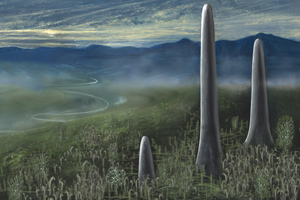Fungus? Fungus.
Paleobotanist C. Kevin Boyce lays to rest a 150-year-old controversy about a 4 million-year-old organism and explores how flowering plants helped create the rainforests.
By Lydialyle Gibson
Photography by Lloyd DeGrane and image courtesy Mary Parrish, National Museum of Natural History
The first time Chicago paleobotanist C. Kevin Boyce read about Prototaxites, a 20-foot-tall organism that loomed like a telephone pole over Earth’s prehistoric landscape, he thought it was a typo. “I figured there was a decimal out of place somewhere,” he says. “Surely they didn’t mean to say it was half a meter across?” Then he saw the same numbers in a different textbook. “And it was like, ‘Oh, it really is that big.’” Still, he didn’t pay much attention: focused on the paleobotany side of a paleontology PhD at Harvard, Boyce was obsessed with leaves. And Prototaxites didn’t have any.

A Prototaxites fossil, Boyce says, is “evocative of a lot of things but diagnostic of nothing.”
But three years ago, this ancient, inscrutable organism made him famous. Since its discovery in the mid-1800s, Prototaxites has been a source of controversy. Canadian geologist John William Dawson studied the earliest fossils unearthed from Gaspé Bay and described the organism in 1859 as a conifer—the name Prototaxites means “early yew.” A decade later botanist William Carruthers venomously mocked that idea, insisting the organism was a marine alga. For the next 130 years, debate raged. Some scientists called Prototaxites a lichen, others a fungus, and still others clung to the notion that it was some kind of tree. “The problem is that when you look up close at the anatomy, it’s evocative of a lot of different things, but it’s diagnostic of nothing,” says Boyce, an associate professor in geophysical sciences and the Committee on Evolutionary Biology. “And it’s so damn big that when whenever someone says it’s something, everyone else’s hackles get up: ‘How could you have a lichen 20 feet tall?’”
In 2001 Smithsonian paleobiologist Francis Hueber published a paper declaring, after 20 years of close morphological study, that Prototaxites was a fungus. Not everyone was convinced, but Boyce thought Hueber was right, and he saw a way to sidestep the morphology and settle the dispute with geochemistry. Analyzing the fossils’ carbon isotopes, which offer clues to what an organism ate, Boyce found “an insanely large isotopic range,” much wider than that of any plant, whose metabolism would have been constrained by photosynthesis. “The only way you get that range,” Boyce says, “is if you’re not producing; you’re consuming.” In other words, Prototaxites wasn’t converting the air’s carbon dioxide into energy; it was feeding on organic matter in the soil. “Meaning: fungus,” Boyce says.
He and his coauthors, including Hueber, published their findings in 2007, to immediate uproar. Headlines around the world hailed the “giant fungus,” and Boyce started receiving urgent e-mails from X-Files fans, UFO watchers, religious fundamentalists, and people who believed their bodies were producing strange, harmful fibers.

Prototaxites predated vertebrate animals.
But what he found most interesting about the study was rarely mentioned: Prototaxites’s existence, from 430 million to 350 million years ago, coincided with the emergence of vascular plants—ferns, conifers, and other ancient species. “There’s an early history of moss and algae,” Boyce says, “and then vascular plants appear and just take over the world.” So he expected Prototaxites’s diet to consist mostly of vascular-plant detritus. But the huge isotopic range suggested otherwise. “That means the takeover was less complete than we thought. Large patches of the world were still not covered by vascular plants.”
Boyce’s follow-up study, published in the March Proceedings of the Royal Society B, went even further, suggesting that Prototaxites—which covered Earth’s landmass—wasn’t eating vascular plants at all. He and coauthor Erik Hobbie, a University of New Hampshire ecologist, analyzed a modern fungus whose isotopic range is similar to Prototaxites’s and whose habitat in the path of a retreating glacier in Washington state resembles an Early Devonian floodplain. Studying the living fungus, Boyce discovered that none of Prototaxites’s isotopic values were consistent with vascular plants. Instead, the organism was likely feeding on algae growing in ephemeral shallow ponds. “It’s still screwy, because there were plenty of vascular plants around.”
Part of the conundrum stems from the fact that vascular plants constitute almost the whole fossil record. “They’re the ones with cell-wall compounds that preserve,” Boyce says. “The fossil record of moss, of soil algae is nothing. It doesn’t mean it wasn’t there, and no paleobotanist fails to understand that. Yet when you see the fossil record go from nothing to this enormous diversity of vascular plants, that’s what you can see. You can tell yourself it isn’t the whole story, but it’s still the story you have.”
A similar theme pervades Boyce’s recent work on flowering plants, a type of vascular plant that vastly outnumbers any other. Also called angiosperms, they clock in at 250,000 to 300,000 species, compared to 800 conifers and 8,000 ferns. About 100 million to 60 million years ago, flowering plants began their own takeover of Earth, aided, Boyce believes, by their leaves’ vein density. “The veins in flowering plants’ leaves are far, far more dense than they are in anything else that ever lived.” The greater a leaf’s vein density, the faster it can shed water—a process called transpiration—which allows faster photosynthesis.
“As they start taking over, flowering plants are conducting photosynthesis two or three times faster than anything else, ever,” Boyce says. “And that matters for the carbon cycle, but water loss is also hugely important for climate.” Half of a rainforest’s rain comes not from the ocean but from plants that take in moisture and release it back to the sky. “Before flowering plants, that recycling would not have existed, and the rainforests would be much, much less expansive.” Modeling the modern world without angiosperm transpiration, he found that “the Amazon collapses by a factor of five.”
Biomaps of the prehistoric world show a similar picture. “Go back to the Triassic”—200 million years ago—“and there is no ever-wet tropical belt,” in part because of ice caps, carbon-dioxide concentrations, and other abiotic factors. But later, a similarly warm planet “has rainforests extending clear out of the tropics,” Boyce says. “You go back 50 million years, and there were rainforests in Denver. Go back 100 million years, and there weren’t. What happened in between was, flowering plants took over the world.”
